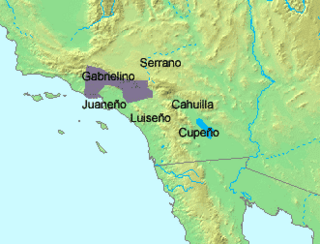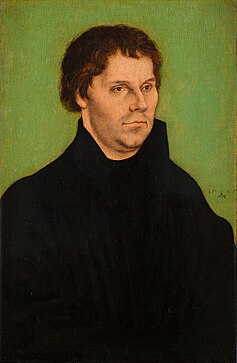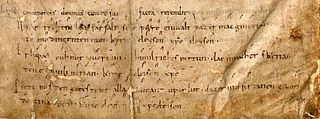Related Research Articles

Deer Park is a village in Lake and Cook Counties, Illinois. Per the 2020 census, the population was 3,681. The village is one of the few left in the Chicago area that enjoy a green belt which is bordered by two large natural areas providing outdoor recreation and open space. The village is home to popular shopping and dining destinations: Deer Park Town Center and the Town Center Promenade. The town is also home to the Vehe Farm, an Illinois Centennial Farm.
The South Huon Gulf languages are a linkage of the Huon Gulf languages of Papua New Guinea.

The Tongva language is an extinct Uto-Aztecan language formerly spoken by the Tongva, a Native American people who live in and around Los Angeles, California. It has not been a language of everyday conversation since the 1940s. The Gabrielino people now speak English but a few are attempting to revive their language by using it in everyday conversation and ceremonial contexts. Presently, Gabrielino is also being used in language revitalization classes and in some public discussion regarding religious and environmental issues. Tongva is closely related to Serrano.

The Diocese of Halberstadt was a Roman Catholic diocese from 804 until 1648. From 1180, the bishops or administrators of Halberstadt ruled a state within the Holy Roman Empire, the prince-bishopric of Halberstadt. The diocesan seat and secular capital was Halberstadt in present-day Saxony-Anhalt.
Jun-ichi Nishizawa was a Japanese engineer and inventor. He is known for his electronic inventions since the 1950s, including the PIN diode, static induction transistor, static induction thyristor, SIT/SITh. His inventions contributed to the development of internet technology and the information age.
Michael Vehe was a German monk and theologian.
Matthias Vehe known as Glirius (c.1545-1590) was a German Protestant religious radical, who converted to a form of Judaism and anti-trinitarianism, rejecting the New Testament as revelation.

Johann Sylvan was a Reformed German theologian who was executed for his heretical Antitrinitarian beliefs.
Daniel Bieliński was a member of the Polish Brethren of whom little is known except for his radical Judaistic views. In early debates among the Brethren he is considered the early leader of Judaizer element, against the more moderate positions of Gregory Paul of Brzeziny, Jan Niemojewski, Georg Szoman, Marcin Czechowic, and Piotr of Goniadz.

"Nun bitten wir den Heiligen Geist" is a German Christian hymn. The first stanza is a leise from the 13th century which alludes to the Latin sequence Veni Sancte Spiritus for Pentecost. It was widely known, and aside from its Pentecostal origin was also used as a procession song and in sacred plays.
András Eőssi of Szenterzsébet, in Harghita, was a Székely nobleman in Transylvania who founded the Szekler Sabbatarians sect. Eőssi came into contact with Matthias Vehe and, after the death of Ferenc Dávid in 1579, set up the Sabbatarian branch of the Transylvanian Unitarians. He was an autodidact, with followers including Simon Péchi and the Unitarian Miklós Bogáthi Fazekas. The first major study on this group was published in Hungarian in 1899 by Samuel Kohn.
Chancellor Simon Péchi (1575–1642) was a Hungarian Székely official, and wealthy supporter of Matthias Vehe and nobleman András Eőssi's Szekler Sabbatarians movement in Transylvania. The influence of Péchi's Sabbatarian prayer book contributed to the conversion of around twenty thousand Székelys to Sabbatarianism in the late sixteenth century. Samuel Kohn, Chief Rabbi of Budapest, and the first scholar to take an interest in the Sabbatarians among the Transylvanian unitarians, published a biography of Péchi as part of his studies in 1899.
"Jesus Christus, unser Heiland, der von uns den Gotteszorn wandt" is a Lutheran hymn in ten stanzas by Martin Luther for communion, first published in 1524 in the Erfurt Enchiridion. It is one of Luther's hymns which he wrote to strengthen his concepts of reformation. The models for the text and the melody of Luther's hymn existed in early 15th-century Bohemia. The text of the earlier hymn, "Jesus Christus nostra salus", goes back to the late 14th century. That hymn was embedded in a Hussite tradition.

"Gott sei gelobet und gebenedeiet" is a Lutheran hymn of 1524 with words written by Martin Luther who used an older first stanza and melody. It is a song of thanks after communion. Luther's version in three stanzas was printed in the Erfurt Enchiridion of 1524 and in Johann Walter's choral hymnal Eyn geystlich Gesangk Buchleyn the same year. Today, the song appears in German hymnals, including both the Protestant Evangelisches Gesangbuch, and in a different version in the Catholic Gotteslob.
Robert Vehe is an American former cyclist. He competed in the 1000m time trial event at the 1976 Summer Olympics.
Dr. József Gáti was an ethnic Hungarian communist politician from Subcarpathian Rus'. Gáti lived in Užhorod. He held a doctorate in Fine Arts. Around 1910 he worked at the newspaper Határszéli Ujság.
Josef Kaminský (1878–1944) was a politician in interwar Czechoslovakia. He died in 1944. He worked as a newspaper editor. He was elected to the Czechoslovak Chamber of Deputies in the 1924 Užhorod electoral district by-election, the sole candidate of the Carpathian Republican Peasants Party elected.

The Leise or Leis is a genre of vernacular medieval church song. They appear to have originated in the German-speaking regions, but are also found in Scandinavia, and are a precursor of Protestant church music.
Munkás Újság was a Hungarian language weekly newspaper published from Uzhgorod, Czechoslovakia 1920-1938.
"Wer unterm Schutz des Höchsten steht" is a Christian hymn in German. The anonymous text, paraphrasing Psalm 91, appeared first in 1972 in a Protestant hymnal, with a 1537 melody from Michael Vehe's hymnal. It is contained in the Catholic hymnal Gotteslob.
References
- ↑ Vehes at Ethnologue (18th ed., 2015) (subscription required)